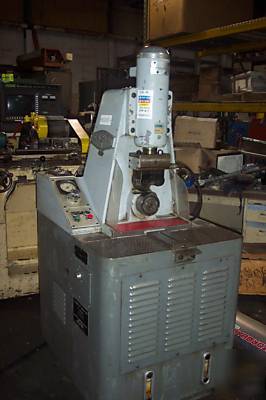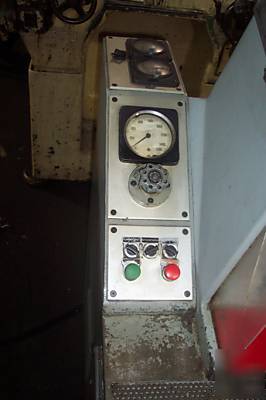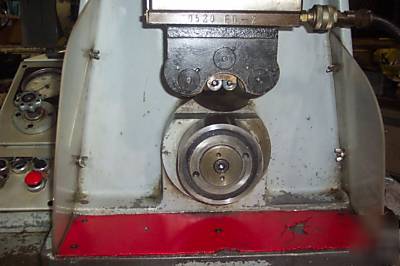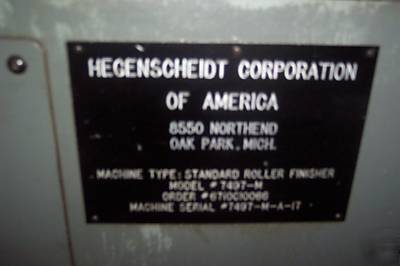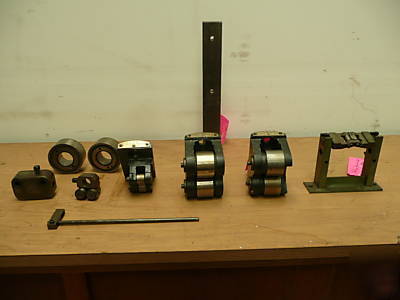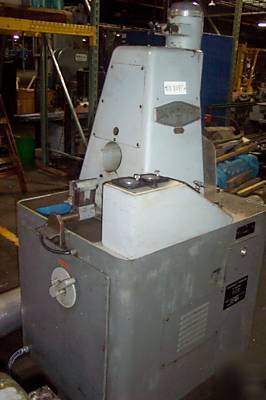Wisconsin Parts Database Instructions and Discussion Team/Group > WISCONSIN
> Motors and tools
> Remove
> Hegenscheidt super roller finishing machine burnishing
Hegenscheidt super roller finishing machine burnishing
THIS ROLLER STYLE SUPER FINISHING MACHINE IS IN GREAT RUNNING ORDER AND CAN BE INSPECTED IN MPLS MN UNDER POWER. TO SET UP AN INSPECTION, PLEASE CALL JIM @ (***)-931-7974. THANK YOU.
HEGENSCHEIDT - FARREL CENTERLESS
Hydraulic Pump Motor....3/4 HP at 1800 RPM
Lubrication Pump Motor..1/8 HP at 3600 RPM
Workpiece diameter range ...1/8 to 1-5/8 inch
Workpiece length without steadyrest ....16 to 24 inch
Workpiece length with steady rest ...Variable
Plunge rolling length.............3/4 to 1-5/8 Inch
Surface speed of drive roller 193/382 ft/min at 1750/3450 RPI
Feed rate (Variable) Max. 3 inch/sec.
Hydraulic system pressure range
230 to 3000 lbs 730 to 9350 lb:
Timer range (pre-selectable) 0 - 15 sec.
Floor space requirements 35 x 45 inch
total weight Approx. 2,800 lbs.
Main drive motor .........1-1/2-3 HP at 1750 - 3450 RPM
1. PRINCIPLFS & APPLICATION, HEGENSCHEIDT-FARREL ROLLER SUPERFINISHING MACHINE - MODEL #7497-M
The basic operation of this machine does not require any great amount of operator skill. It does, however, require a clear and full understanding of the basic principles of Roller Superfinishing.
This machine operates on the principle that the peaks of previously machined surfaces are compressed by the rolling action of hardened steel rollers and applied hydraulic pressure, working against the surface roughness. This cold working process when properly set up and controlled exceeds the yield strength of the material and plastically causes the material to flow. (See layout #1).
The machine is designed to operate with three rollers confining the workpiece on a centerless principle. This center-less principle will allow workpieces of long length to pass through the machine. The head assembly of this machine is designed to permit the entire roller superfinishing head to be turned in a clockwise direction. The thru-feeding of work is caused by the action of the superfinishing rollers having axes skewed at and angle to the axis of the drive roller.(See layout #2).
When superfinishing parts with a short bearing contact of 1-3/4" or less the "plunge" method is used. On this application the axis of the superfinishing roller is parallel to the axis of the drive roller producing rotation but no lateral feed.
In this operation, roller superfinishing action is controlled by a pre-selectable timer. Parts with a short bearing
length can be roller superfinished by feeding through the machine against a positive limit switch. Parts with shoulders
can be started with the face of the shoulder against the drive roller and the part piece feeding out. The parts also can be fed into the machine and stopped with a limit switch before the shoulder comes in contact with the face of the superfinishing rollers. Parts of long length, that have a tendency to whip due to the speed of rotation, should be supported with a roller steadyrest.
The radius on the edge of the drive roller, as well as the superfinishing rollers, is the limiting factor which determines how close these rollers can come against a shoulder. Rollers can be made with a radius as small as .005", allowing roller superfinishing parts with a surface roughness not to exceed 140 R.M.S.
Once the pressure of the machine has been set, and the feed regulated, it is possible to roller superfinish a shaft with a number of diameters, by using one setting. The amount of vertical travel of the head, after the roller superfinishing action, is also controlled by a pre-selectable timer. This can be adjusted from 1/16" - 2".
The various superfinishing heads have a generated radius on the mounting surface to the piston rod. This provides inclination of the roller heads to the axis of the drive roller. Depending on the inclination the force per unit area will vary.
An inclination is necessary for thru-feeding tough material with a coarse surface roughness.
Roller superfinishing produces a high quality surface finish with corresponding increases in surface hardness,
increased resistance to wear, increased effective bearing area, and resistance to corrosive fatigue. High residual compressive stresses are imposed on the outer surface of the material. This is a cold-working process, and as a result, considerable improvement in the fatigue strength characteristic of the material is achieved.
It is possible, in one pass, to roller superfinish material with a controlled surface roughness of 150 micro-inches to 2 - 3 micro-inches in approximately one second per inch of feed. Materials such as aluminum, brass, bronze, cast iron, low carbon and high alloy steels, are suitable for roller superfinishing. The maximum hardness range of roller superfinishing is approximately 48 to 50 Rockwell C. Above this range it is impossible to exceed the yield point of the material and make it flow plastically. The ideal range of roller superfinishing for maximum metal flow is from 20 - 40 Rockwell C.
When roller superfinishing screw machine material with high sulpher, phosphorus, and lead content a minimum of pressure and rolling time must be used to prevent surface failure. These types of material should not have a surface roughness exceeding 60 - 80 R.M.S. prior to roller superfinishing. The same practice will also apply to some grades of cast iron and Meehanite. In normal practice, higher grades of materials such as alloys and stainless steel, produce finishes of 2 to 3 micro-inches very easily.
The Roller Superfinishing Machine will not size material, only flow the surface roughness of the material to produce the desired finish. Tolerances of .0001" to .0002" can be held with this machine, depending upon the controlled size and surface finish in the preliminary operation.
This process results in a reduction in diameter of the workpiece which is approximately four times the RMS Factor expressed in micro-inches. As an example, a turned surface with
a finish of 125 micro-inches will reduce approximately .0005" in diameter. A ground part, with a surface finish of approximately 25 micro-inches, will reduce .0001" in diameter. This reduction in diameter can be controlled and regulated to consistently produce parts which are uniform in size. (See layout #6).
When estimating reduction in diameter the yield strength of the material must be considered. The reduction which occurs is a factor of the surface roughness which is displaced as well
as the compressibility of the material. The best way to determine the reduction in diameter is to roller superfinish a test piece.
The machine is arranged to utilize four (4) heads of various capacities which are easily interchangeable in approximately 3 minutes time.(See paragraph 2.3)
The life of the drive roller and the roller superfinishing rollers is determined by the total usage of the machine. These rollers are designed so that they are easily removed from the macbine and may be reground, polished, and replaced in a minimum amount of time. A typical production run of 300 hours, before regrind and polishing, is possible.
The workpiece is lubricated during the rolling cycle
with a light spindle oil of approximately 55 - 60 S.S.U. viscosity at 100 F. The oil, retained by the top tray of the machine, is filtered and re-cycled by an enclosed lubrication system.
In some cases the application of roller superfinishing will eliminate heat treating. This is possible because of the increase in effective bearing area, and surface hardness.
Surface hardness can be increased from 10 to 60%, measured on the Brinell Scale, depending upon the structure of the material, the rolling pressure and the rolling time. It is well to remember that, on some applications, the increase in surface hardness is not aS important as the increased resistance to wear because of the increase in effective bearing area of the roller superfinished surface.
A high accurate superficial tester with a light preload must be used to measure increase in surface hardness. This is necessary so as not to penetrate the surface skin
PRICE LOADED ON YOU TRUCK $8950.00 MY ZIP CODE IS 55343
